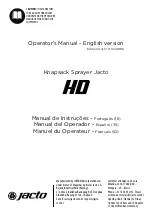
FMT6099
Instruction Manual
Fast Mover Tools Ltd
T: 01582 661993 F: 01582 667100 E: [email protected]
W: www.fastmovertoolsuk.com
medication.
38
Do not spray at or near and naked flame or any source of ignition.
39
DO NOT spray any material without first consulting a Material Safety Data Sheet. If one
is not available it is advised that you source an alternative material.
40
Be aware of the dangers of working in or on and building or material containing asbestos.
Always take a appropriate measures up to an including contracting licensed 3rd parties
to remove and/or make safe any asbestos.
41
If the material sprayed makes contact with eyes, skin or enters the respiratory system
take appropriate measures as advised by the HSE and your own Health and Safety
guidelines. If in doubt, seek medical help.
42
NEVER point air supply hose at yourself or others.
43
Be aware of the dangers and hazards of spraying isocyanate based paints.
Operating Instructions
Preparation
To obtain the best results, it is important that you prepare the surface to be sprayed and thin the
paint to the correct viscosity before you start work. Always ensure that the surface to be sprayed is
free from dust, dirt, grease and other foreign bodies. Always mask the areas around the areas to
be sprayed using good quality masking tape. The paint to be sprayed should be suited to the task
and compatible with your spraygun. There should be no lumps or other particles. Make sure that
you have a properly working strainer. Many substances can be sprayed with this gun buy it is im-
portant that you check with your paint supplier before purchasing your paint. It is very important
that you check the panel for signs of silicone contamination
before
starting work.
Thinning
Most paints are supplied ready for the type of application and applying technique but may have to
be thinned for use with your spraygun. Always follow the paint manufactures advice on thinning
paint. A viscosity cup will help you determine the correct viscosity of the paint to be used. To
measure the viscosity of the paint fill the cup to the brim and measure the length of time it take to
empty. The table below shows the recommended times for different materials. Please note that
this is intended as a guide only and you should advice from your paint supplier.
Plastic & Latex
24-28secs
Water based Paint
20-25secs
Primers
24-28secs
Varnishes
20-25secs
Oil based paints
18-22secs
Enamel paints
18-22secs
Aluminium paints
22-25secs
Car underseal
25-35secs
Wood sealers
28-35secs
Wood preservatives
Not required
Wood stains
Not required
If the paint takes longer than the recommended time to empty, further thinning is required. Mix a
small quantity of the appropriate thinner and use the viscosity cup again until the required figure is
achieved. Some paints contain lumps and particles and these should be strained before use.
Spraying
Fill the paint cup with the appropriately thinned paint and screw onto the gun. Connect the air hose
switch on compressor. See
Fig.1
for the recommended air line setup It is recommended that you
use a test card or scrap panel to make sure that the paint is correct. This also aids comparison
with existing paint work.
To get best results, keep your spraygun level and at 90
o
to the surface at all times (see
Fig.2
).
Keep the nozzle 200-300mm from the surface and spray evenly from side to side or up and down.
Spraying at an angle will lead to paint runs. Use smooth, even strokes. When spraying large
FMT6099_Product Instructions 10/05/2013 10:59 Page 4


























